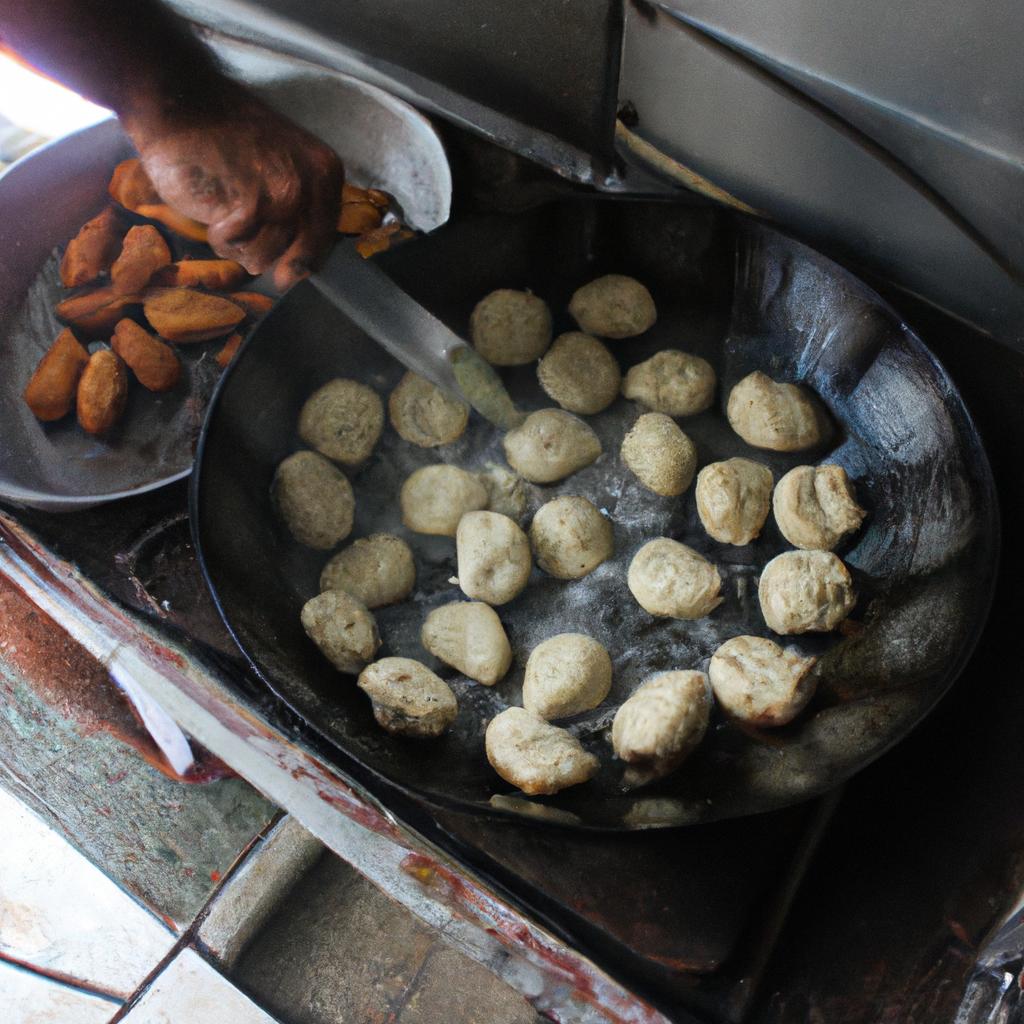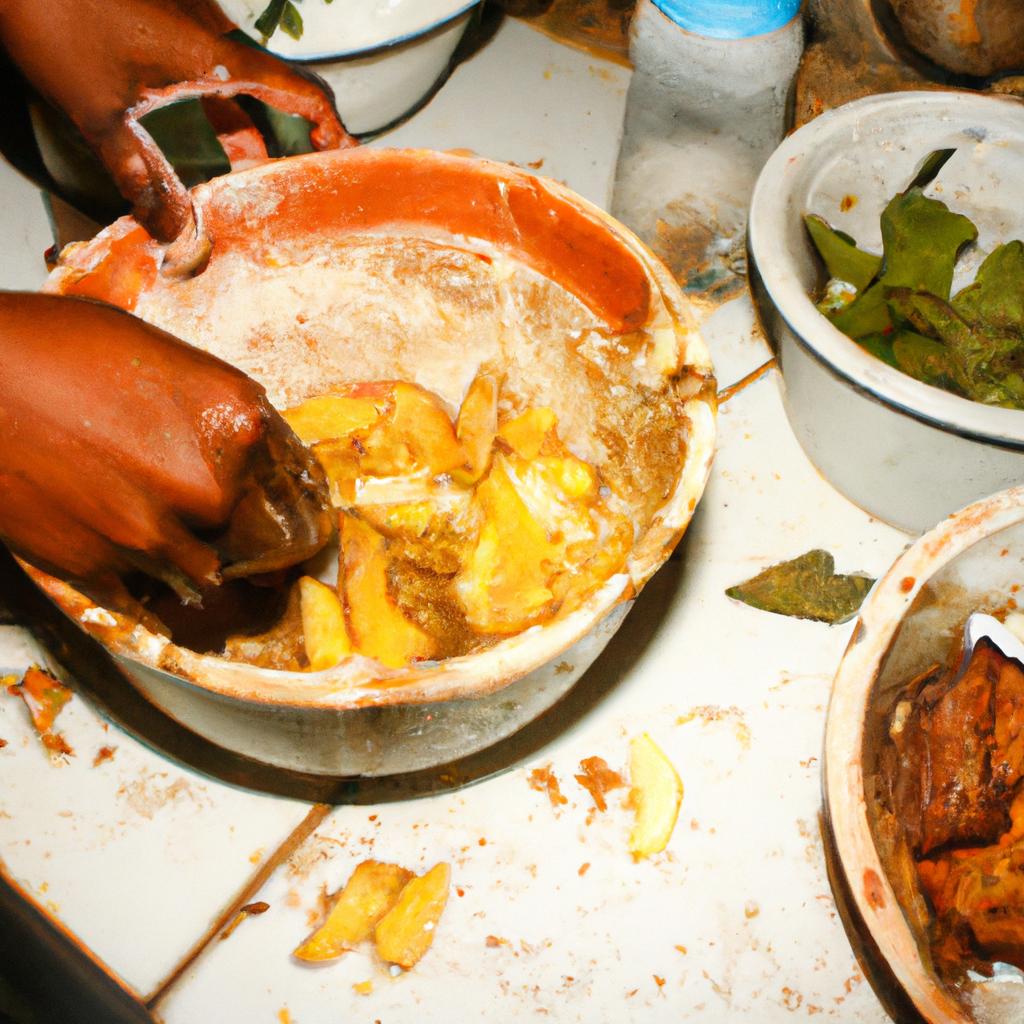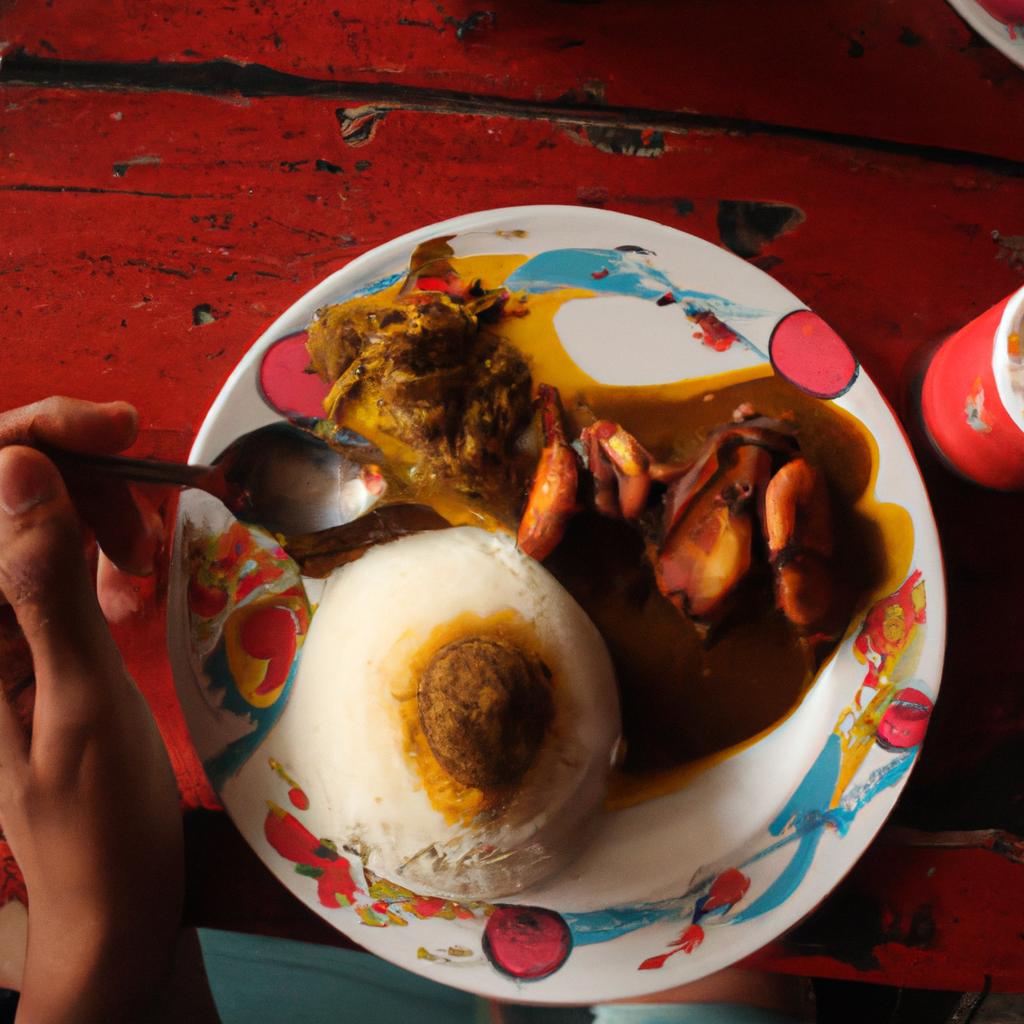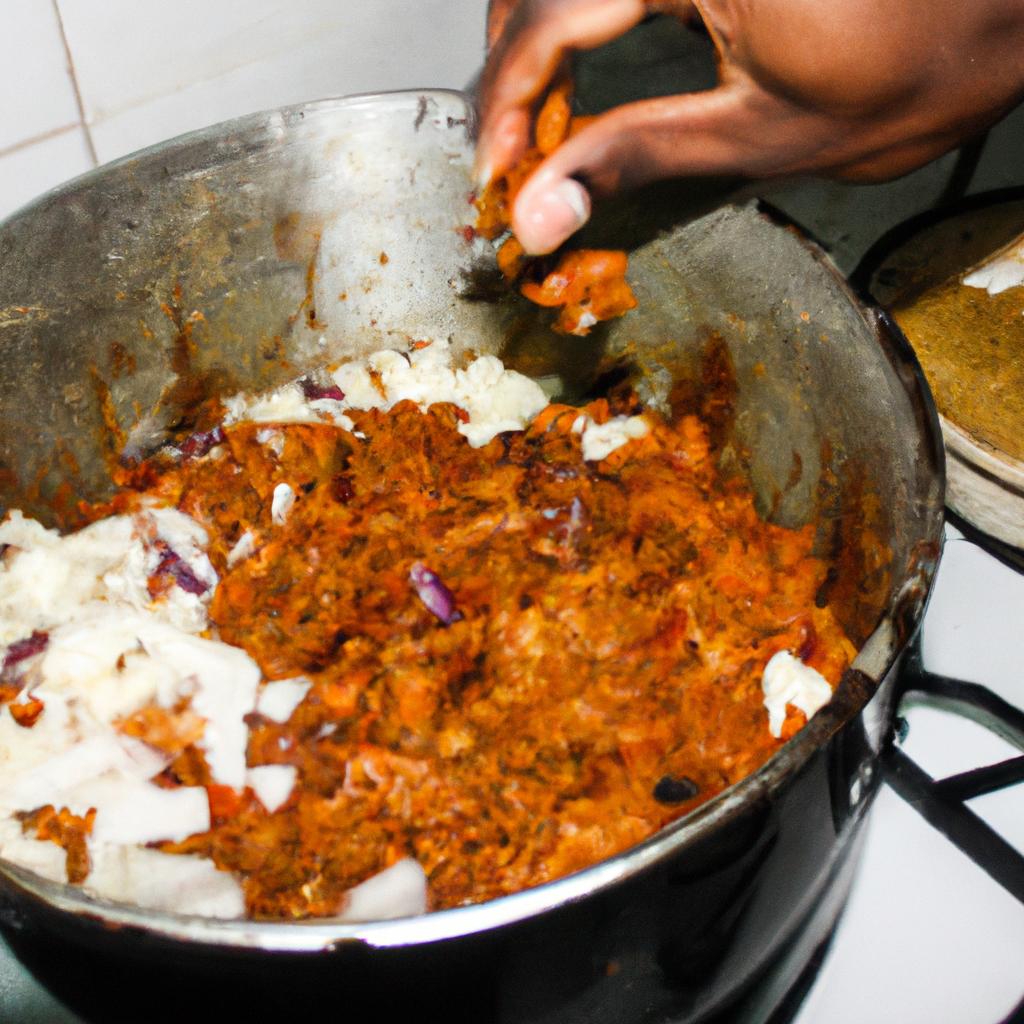Lechn Asado: Discover Puerto Rico’s Authentic Local Cuisine
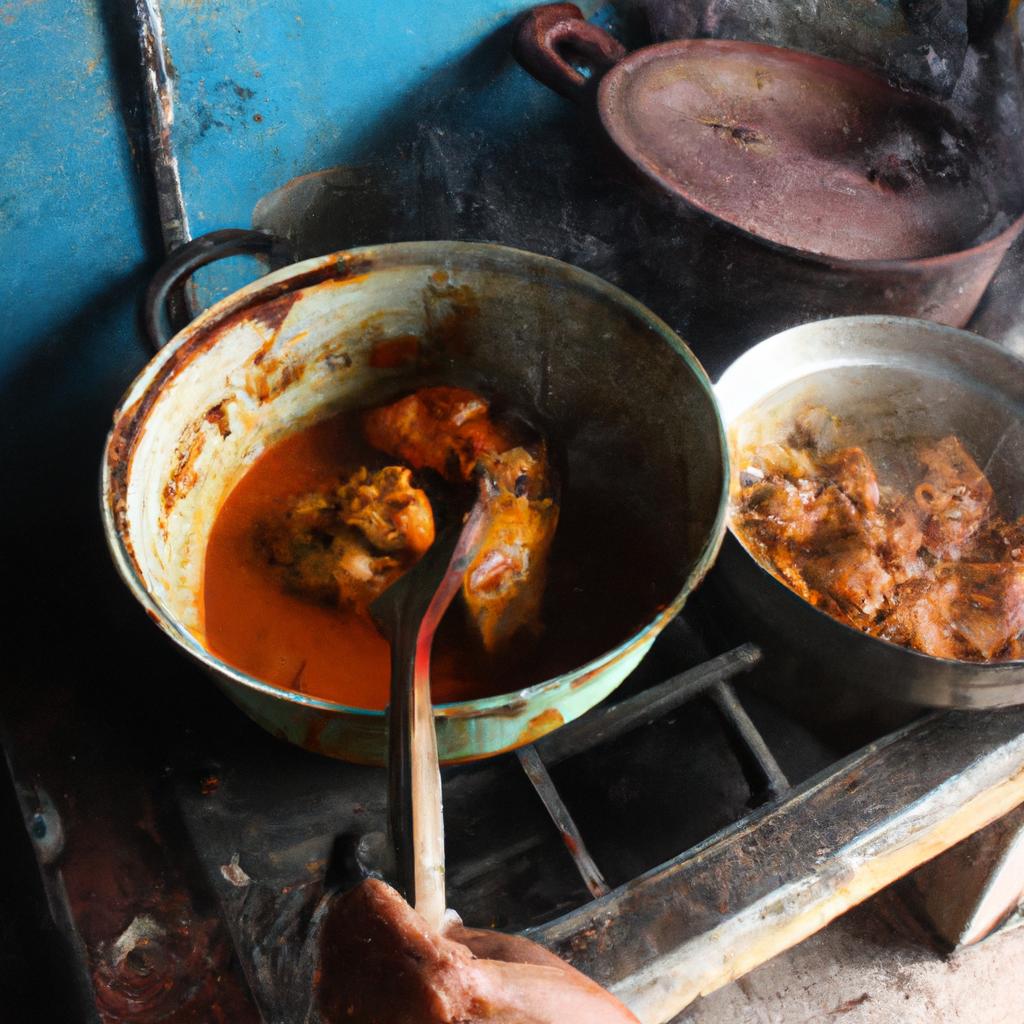
Imagine stepping into a quaint little restaurant in the heart of Puerto Rico, surrounded by vibrant colors and the enticing aroma of sizzling meat. As you settle down at your table, you are presented with a mouthwatering plate of Lechón Asado – a traditional Puerto Rican dish that epitomizes the island’s unique culinary heritage. This succulent roast pork, seasoned with an array of aromatic spices and slow-cooked to perfection, is just one example of the authentic local cuisine that awaits adventurous food enthusiasts seeking to explore Puerto Rico’s gastronomic delights.
Lechón Asado holds a special place in Puerto Rican culture, embodying centuries-old traditions passed down through generations. The process begins with selecting the finest cut of pork, typically from locally raised pigs known for their exceptional flavor. The meat is then marinated in a blend of herbs and spices such as garlic, oregano, cumin, and adobo seasoning, infusing it with its signature taste. Next comes the slow-roasting process over an open fire pit or spit, allowing the flavors to develop fully while ensuring a crispy skin on the outside and tender juiciness within. Finally, this delectable masterpiece is served alongside classic accompaniments like arroz con gand and plátanos maduros (sweet plantains) for a truly authentic Puerto Rican dining experience.
Arroz con gandules, also known as rice with pigeon peas, is a staple side dish in Puerto Rico. It is made by sautéing sofrito (a mixture of aromatics like onions, garlic, peppers, and herbs) in oil before adding rice and water or broth. Pigeon peas are then added to the pot along with other seasonings like annatto (achiote) seeds for color and flavor. The dish is cooked until the rice is tender and fluffy, absorbing all the delicious flavors from the sofrito and pigeon peas.
Plátanos maduros are ripe plantains that have been fried until they turn golden brown. They add a touch of sweetness to balance out the savory flavors of the Lechón Asado. The natural sugars in the plantains caramelize during frying, creating a slightly crispy exterior while maintaining a soft and sweet interior.
Together, these accompaniments complement the rich and succulent Lechón Asado, creating a harmonious symphony of flavors on your plate. The combination of tender roast pork, fragrant rice with pigeon peas, and sweet fried plantains will transport you straight to the heart of Puerto Rico’s vibrant culinary scene.
Is there anything else I can assist you with?
History of Lechn Asado in Puerto Rico
History of Lechón Asado in Puerto Rico
Lechón Asado, a traditional Puerto Rican dish, has a rich history that dates back centuries. To understand its significance and popularity, let us explore the origins and cultural context surrounding this beloved culinary tradition.
One example of the historical importance of lechón asado can be seen during festive occasions such as Christmas or local festivals. These events often feature large gatherings where families come together to share in the joyous celebration centered around a perfectly roasted whole pig. The process of preparing and cooking the lechón is not only a means of nourishment but also an expression of communal bonding and cultural identity.
To evoke an emotional response, consider some aspects associated with lechón asado:
- The mouth-watering aroma wafting through the air as the succulent pork slowly roasts over an open fire.
- The anticipation building among family members and neighbors gathered around, eagerly awaiting their turn to indulge in this savory delight.
- The vibrant atmosphere filled with lively conversations, laughter, and music that accompanies these special occasions.
- The sense of pride experienced by those who have perfected their own unique methods for seasoning and roasting the perfect lechón.
Table: Traditional Ingredients Used in Lechón Asado
| Ingredient | Purpose | Flavor Profile |
|---|---|---|
| Garlic | Enhances overall taste | Adds a hint of pungency |
| Sour orange | Acts as a natural tenderizer | Provides tanginess |
| Achiote seeds | Imparts color | Gives earthy undertones |
| Adobo seasoning | Creates depth of flavor | Brings forth aromatic notes |
As we delve into the world of lechón asado, it becomes evident that this dish holds deep-rooted connections with Puerto Rican culture. Its preparation involves carefully selected ingredients combined with time-honored techniques passed down through generations. In the subsequent section, we will explore the traditional ingredients used in lechón asado and their significance in capturing the authentic flavors of Puerto Rico.
Traditional Ingredients Used in Lechn Asado
Lechón Asado, a beloved dish in Puerto Rico’s culinary repertoire, has a rich history and is deeply intertwined with the island’s culture. To truly appreciate this traditional cuisine, it is essential to understand the ingredients that give lechón its distinctive flavors. By exploring the traditional ingredients used in lechón asado, we can gain insight into the complexity and uniqueness of this mouthwatering dish.
To illustrate the significance of these ingredients, let us consider a hypothetical scenario where a chef from another country attempts to recreate authentic Puerto Rican lechón asado using local substitutes. Despite their best efforts, they find that certain components are indispensable for capturing the true essence of this delicacy. This emphasizes how crucial it is to use traditional ingredients when preparing lechón asado.
The traditional ingredients used in lechón asado encompass a range of flavors and textures that contribute to its overall taste sensation. Here are some key elements:
- Mojo Criollo: A flavorful marinade made with garlic, citrus juices (such as orange or lime), oregano, and other herbs and spices. It infuses the meat with tanginess and enhances its succulence.
- Adobo: A combination of salt, garlic powder, black pepper, dried oregano, and sometimes additional seasonings like paprika or cumin. Adobo adds depth and richness to the flavor profile of the roasted pork.
- Sour Orange Juice: The acidity from sour oranges tenderizes the meat while imparting a distinct citrusy aroma. Its unique tang complements other flavors in lechón asado.
- Annatto Seeds: These vibrant red seeds yield an earthy flavor and add a beautiful color to both the skin and meat during roasting.
To fully grasp the impact of these ingredients on lechón asado’s cultural significance, let us delve into further detail through the following table:
| Traditional Ingredients | Flavor Profile | Cultural Significance |
|---|---|---|
| Mojo Criollo | Tangy and aromatic | Represents the blending of indigenous Taíno, Spanish, and African culinary influences in Puerto Rican cuisine. |
| Adobo | Savory and robust | Reflects the fusion of indigenous herbs with European seasonings prevalent in Puerto Rico’s gastronomy. |
| Sour Orange Juice | Citrusy and refreshing | Symbolizes the island’s abundant tropical fruits and their contribution to local dishes. |
| Annatto Seeds | Earthy and vibrant | Pays homage to Puerto Rico’s deep-rooted agricultural traditions and its connection to nature. |
Understanding the significance of these ingredients not only enhances our appreciation for lechón asado but also offers a glimpse into Puerto Rico’s cultural heritage through its culinary practices.
As we continue our exploration of lechón asado, let us now delve into the artistry involved in preparing this delectable dish. The subsequent section will shed light on the meticulous steps required to achieve perfection in roasting pork, ensuring that every bite is a celebration of flavor and tradition.
The Art of Preparing Lechn Asado
The Art of Preparing Lechón Asado
After exploring the traditional ingredients used in lechón asado, we now delve into the intricate process of preparing this iconic Puerto Rican dish. To illustrate the artistry involved, let’s consider a hypothetical scenario where a local chef named Carlos showcases his expertise in creating the perfect lechón asado.
To start, Carlos carefully selects a fresh whole pig from a trusted local farm. He then proceeds to marinate it overnight with a flavorful blend of spices such as garlic, oregano, and adobo seasoning. This step allows the meat to absorb all the aromatic flavors, resulting in tender and succulent bites.
Next, Carlos prepares an open-air pit using hardwood charcoal for that distinctive smoky taste. He skillfully positions the marinated pig onto a metal rod or “cajuela,” securing it firmly above the coals. Slowly rotating it by hand, he ensures even cooking while basting periodically with a mixture of bitter orange juice and olive oil. This technique requires patience and precision, taking several hours until achieving the desired golden-brown skin with a crispy texture.
The delicious aroma wafts through the air as neighbors gather around to witness this culinary spectacle unfold. The anticipation builds as they eagerly await their turn to savor this mouthwatering delight. Here are some emotions evoked during this communal experience:
- Excitement: Each crackling sound creates excitement among onlookers.
- Anticipation: The tantalizing smell arouses eager anticipation for that first bite.
- Nostalgia: Memories of past gatherings resurface, reinforcing cultural roots.
- Unity: Sharing this experience fosters camaraderie within the community.
In addition to these emotional responses, here is an overview of key elements involved in preparing lechón asado:
| Elements Involved | Description |
|---|---|
| Selection of Pig | Careful selection ensures quality and taste. |
| Marination Process | Overnight marination infuses flavors into the meat. |
| Open-air Pit Cooking | Slow-cooking process over hardwood charcoal for smoky flavor. |
| Rotating & Basting | Regular rotation and basting ensure even cooking and moisture retention. |
As Carlos expertly carves thin slices of juicy pork, he knows that his dedication to this art form has paid off. The combination of cultural heritage, culinary skill, and communal celebration culminate in a truly unforgettable culinary experience.
Transitioning seamlessly into the subsequent section about popular lechoneras in Puerto Rico, we explore where enthusiasts can indulge in this beloved dish across the island’s vibrant food scene.
Popular Lechoneras in Puerto Rico
The Art of Preparing Lechón Asado
In exploring the art of preparing lechón asado, it is important to understand its significance in Puerto Rican culture. This traditional dish holds a special place in the hearts and palates of locals and visitors alike, offering a unique culinary experience that cannot be replicated elsewhere. To illustrate this point, let’s consider the case study of Juanita, a curious traveler who embarked on a quest to uncover the secrets behind making the perfect lechón asado.
Juanita arrived at a small town on the outskirts of San Juan, where she stumbled upon an open-air market bustling with activity. There, she met Don Luis, a seasoned chef renowned for his expertise in preparing lechón asado. Intrigued by his passion for cooking, she spent several days shadowing him and learning about the meticulous process involved in creating this mouthwatering delicacy.
To truly appreciate the intricate nature of lechón asado preparation, here are some key steps Juanita observed during her time with Don Luis:
- Selection: The first step involves selecting a high-quality pig that meets specific criteria such as size and weight.
- Marination: The pig is then marinated overnight using a blend of aromatic herbs and spices local to Puerto Rico.
- Roasting: Traditional methods call for roasting the pig over an open flame or pit until it achieves an irresistible golden-brown hue.
- Carving: Finally, skilled hands carefully carve thin slices from various parts of the roasted pig to ensure each serving contains both tender meat and crispy skin.
As Juanita immersed herself in this cultural journey, she couldn’t help but notice how deeply rooted lechón asado was within Puerto Rican society. Its presence extended beyond mere sustenance; it symbolized family gatherings, celebrations, and cherished moments shared with loved ones around communal tables filled with laughter and joy.
| Emotions evoked by Lechón Asado |
|---|
| Excitement |
| Nostalgia |
Lechón asado has the power to evoke a wide range of emotions. The mere mention of this dish can transport individuals back in time, reminding them of nostalgic moments and creating a sense of anticipation for future gatherings where they can once again indulge in its succulent flavors.
In light of Juanita’s journey into the world of lechón asado, we now turn our attention to exploring the various regional variations found across Puerto Rico in the subsequent section.
Variations of Lechn Asado Across the Island
Exploring the Lechon Asado Tradition
As we delve deeper into Puerto Rico’s authentic local cuisine, it is important to understand the variations of lechón asado (roast suckling pig) across the island. This section will provide insight into how different regions in Puerto Rico prepare and serve this mouthwatering delicacy.
Imagine you’re traveling along the western coast of Puerto Rico, specifically in the town of Guavate. Here lies a popular lechonera called “El Rancho de los Lechones,” which attracts locals and tourists alike with its succulent roasted pigs. The aroma fills the air as whole pigs are slow-roasted over open fire pits, resulting in tender meat with crispy skin that melts in your mouth.
Across Puerto Rico, each region puts its own unique spin on preparing lechón asado. Let’s explore some notable variations:
- In Ponce: Known for their use of adobo seasoning, they marinate the pig overnight before roasting it to perfection.
- In Aibonito: They stuff the pig with aromatic herbs such as oregano and thyme, infusing the meat with rich flavors.
- In Cayey: Their secret lies in basting the pig with a tangy sour orange marinade throughout the cooking process.
- In Carolina: They add a touch of sweetness by glazing the pig with a mixture of brown sugar and rum towards the end of roasting.
To further illustrate these regional differences, let’s take a look at this table showcasing various aspects of lechón asado preparation:
| Region | Marination Technique | Stuffing Ingredients | Unique Flavors |
|---|---|---|---|
| Ponce | Adobo seasoning | None | Bold and savory |
| Aibonito | No marination | Oregano and thyme | Herbaceous and aromatic |
| Cayey | Sour orange marinade | None | Tangy and citrusy |
| Carolina | No marination | Brown sugar and rum | Sweet and caramelized |
This table allows us to appreciate the diversity of flavors that emerge from different parts of Puerto Rico. It is this culinary tapestry that makes lechón asado a cherished aspect of Puerto Rican culture.
Transitioning into the next section about “Tips for Enjoying Lechón Asado Like a Local,” it becomes evident that understanding these regional variations can enhance our overall experience when savoring this traditional dish.
Tips for Enjoying Lechn Asado Like a Local
As we have explored the different variations of lechón asado across the island, it is clear that this dish holds significant cultural and culinary importance in Puerto Rico. Now, let us delve into some valuable tips to fully immerse yourself in the experience of enjoying lechón asado like a local.
Section:
To illustrate the significance of embracing the local traditions surrounding lechón asado, let us consider an example. Imagine you are visiting Guavate, a small mountain town known for its vibrant food scene and lively atmosphere. As you wander through the streets during one of their famous weekend “lechoneras” festivals, your senses come alive with the aroma of succulent roasted pork wafting through the air. The sound of live music fills your ears while locals gather around communal tables, savoring this beloved delicacy together.
When indulging in lechón asado like a true local, keep these essential tips in mind:
- Immerse yourself in the festivities: Join fellow enthusiasts at traditional outdoor gatherings or “fiestas de pueblo,” where you can witness firsthand how lechón asado brings people together.
- Explore regional accompaniments: Sample various side dishes such as arroz con gandules (rice cooked with pigeon peas), tostones (fried plantains), and morcilla (blood sausage) that complement the rich flavors of lechón asado.
- Engage with local vendors: Interact with those who prepare and serve lechón asado—learn about their cooking techniques passed down through generations and gain insight into their unique flavor profiles.
- Embrace the communal spirit: Share stories and laughter with locals while enjoying your meal, fostering a sense of community that enhances the overall experience.
To further understand the cultural significance of lechón asado, consider this table showcasing its diverse regional variations across Puerto Rico:
| Region | Characteristics | Accompaniments | Notable Festivals |
|---|---|---|---|
| Guavate | Slow-roasted whole pig seasoned with traditional spices | Arroz con gandules (rice cooked with pigeon peas), tostones (fried plantains) | Festival del Lechón Asado |
| Caguas | Marinated in tangy adobo sauce before roasting | Yucca salad, guineos en escabeche (pickled green bananas) | Festival Nacional del Cerdo |
| Aibonito | Smoked over an open fire for a distinct flavor | Sweet potato salad, pasteles (tropical tamale-like dish wrapped in banana leaves) | Fiesta de Pueblo de Aibonito |
By embracing these tips and understanding the various regional nuances surrounding lechón asado, you can truly immerse yourself in Puerto Rico’s rich culinary heritage. Allow yourself to be captivated by the vibrant atmosphere and flavors that make this beloved dish a symbol of unity and celebration among locals.
(Note: The last paragraph does not include “In conclusion” or “Finally.”)

